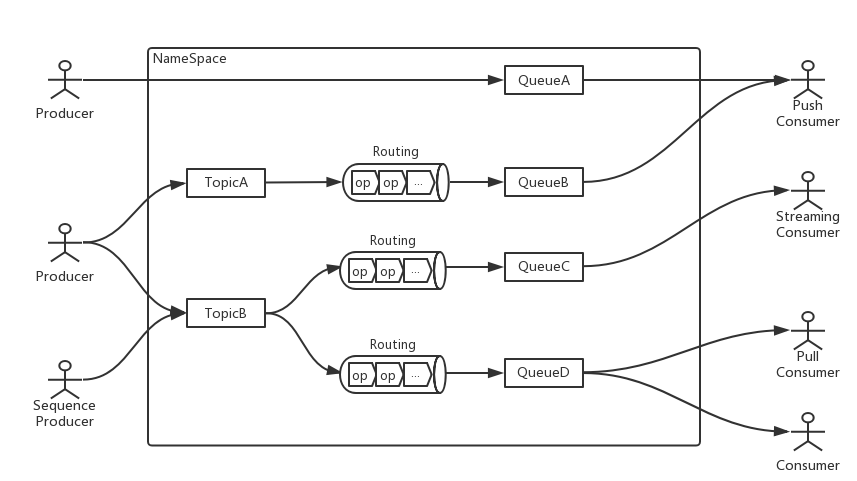September 12, 2017 / by yukon / In design
OpenMessaging Domain Architecture V0.1
Above is the domain architecture of Open Messaging, see JavaDoc for details.
OpenMessaging has released first alpha version recently, Apache RocketMQ has provided a partial implementation for OpenMessaging-0.1.0-alpha.
Namespace
Namespace likes a cgroup namespace, to create an isolated space with security guarantee. Each namespace has its own set of producer, consumer, topic, queue and so on. OpenMessaging uses MessagingAccessPoint to access/read/write the resources of a specified Namespace.
Producer
OpenMessaging defines two kinds of Producer: Producer and SequenceProducer.
- Producer, provides various send methods to send a message to a specified destination, Topic or Queue. Three ways are supported: synchronous, asynchronous and oneway.
- SequenceProducer, focuses on speed, the implementation can adopt the batch way, send many messages and then commit at once.
Consumer
OpenMessaging defines two kinds of Consumer: PullConsumer, PushConsumer and StreamingConsumer. Each consumer only supports consume messages from the Queue.
- PullConsumer, pulls messages from the specified queue, supports submit the consume result by acknowledgement at any time. One PullConsumer only can pull messages from one fixed queue.
- PushConsumer, receives messages from multiple queues, these messages are pushed from the MOM server. PushConsumer can attach to multiple queues with separate MessageListener and submit consume result through ReceivedMessageContext at any time.
- StreamingConsumer, a brand-new consumer type, a stream-oriented consumer, to integrate messaging system with Streaming/BigData related platforms easily. StreamingConsumer supports consume messages from partitions of a specified queue like a iterator.
Topic Queue and Routing
These three concepts are closely connected, although Topic and Queue have different responsibilities, they are confusing. Topic
- Topic, the carrier of origin messages, is responsibility for holding messages. The distribution and sequential of messages in Topic is undefined.
Routing
The messages in Topic are original, waiting for processing, which always can’t arouse the interests of consumers. In a word, the messages in Topic is producer-oriented, not consumer–oriented.
So the Routing is in charge of processing the original messages in Topic, and routing to Queue. Each Routing has a operator pipeline, consists of a series of operators. The messages will flow through the operator pipeline from Topic and Queue.
A operator is used to handle the flowing messages in Routing. There are many kinds of operator, expression operator, deduplicator operator, joiner operator, filter operator, rpc operator, and so on.
What’s more? Routing can cross the network, message can be routed from a network partition to another partition.
Queue
The messages have been routed to Queue, now can be consumed by consumers. It is noteworthy that a Queue should be divided into partitions, a message will be routed to a specified partition by MessageHeader#SHARDING_KEY.
Queue also accepts messages from Producer directly, sometimes, we want to the shortest path from Producer to Consumer, for performance.
Topic vs. Queue
Both Topic and Queue are the carrier of messages. Topic is producer-oriented, while Queue is consumer-oriented. Messages in Topic are from Producer, while messages in Queue is from Topic or Producer. Queue is divided into partitions, while the arch of Topic is undefined. Queue is a little sub set of a Topic in most cases. Create or destroy a Queue is easy and producer irrelevant.


